

Painted and Indigo Buntings,Doves,Pileated Woodpeckers,Red Bellied Woodpeckers, Squirrels,Cardinals,Wrens,Northern Parula Warblers,Osceola Turkeys,Racoons and Hawks visit our yard..while Osprey..an occasional Swallowtail Kite or Bald Eagle can be seen soaring overhead.. We live in a hammock area... Thickly wooded with palms, live oaks, red maples, needle palms and a soil(muck)that is like potting soil.


In February a large flock of Robins came in. They feed on berries and insects..etc. Along with them came a small flock of Cedar Waxwings. I think this is my husband’s favorite bird. He likes the bandit look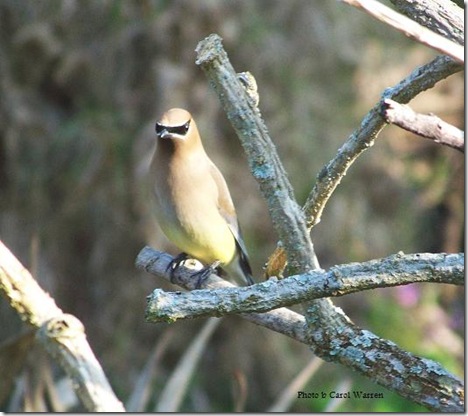 and the cocky little attitude.
and the cocky little attitude.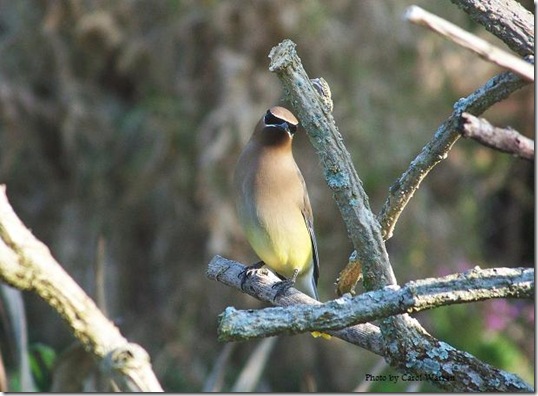
He was more than willing to pose for the pictures….almost as though he were trying to show off his best side.
You can just see the yellow on the tip of his tail, below the branch.
 They came in with the Robins. At that time the Peppertrees were producing red berries. This is a non-native..invasive tree and it really takes over. We waited for the birds to eat and leave before trimming them back. The Robins came to the bird bath in large numbers, and the Cedar Waxwings with them. Sometimes the edge was full of birds with many sitting in the bushes or the Tangelo tree waiting for a turn. The photo shows 2 Cedar Waxwings and a Catbird joining them.
They came in with the Robins. At that time the Peppertrees were producing red berries. This is a non-native..invasive tree and it really takes over. We waited for the birds to eat and leave before trimming them back. The Robins came to the bird bath in large numbers, and the Cedar Waxwings with them. Sometimes the edge was full of birds with many sitting in the bushes or the Tangelo tree waiting for a turn. The photo shows 2 Cedar Waxwings and a Catbird joining them.
We have several Gray Catbirds that visit the birdbath. They are a medium sized songbird. They normally come in when all the other birds are at the feeders. I’ve counted 6 in the jasmine bush…each waiting a turn at the water.
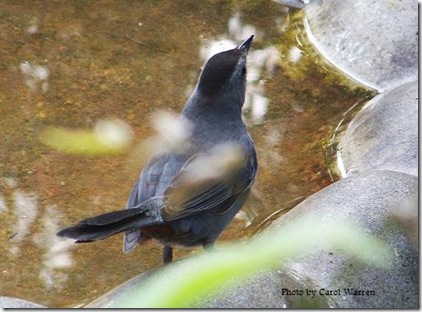 They are a beautiful, warm shade of gray with a black cap on the top of their head…and the ends of the tail feathers. They flick their tails while sitting and sometimes you can see the rust colored spot under their tails.
They are a beautiful, warm shade of gray with a black cap on the top of their head…and the ends of the tail feathers. They flick their tails while sitting and sometimes you can see the rust colored spot under their tails.
I was surprised to see this squirrel come to the birdbath. It is the only one that does…but she is a regular at the area under the feeders….the first time I saw her on the bird bath…I assumed she was jumping to the feeders….she was….so I had to move them out of her reach. She was drinking when I got the camera but saw me come to the window and posed for this instead. 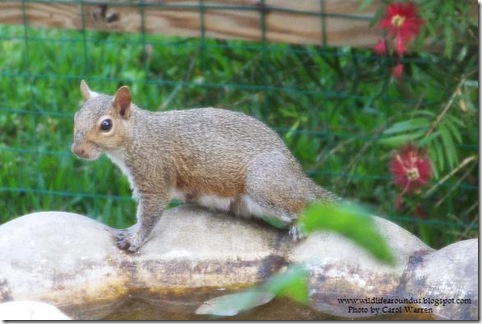 Water can be very important during the winter..our dry period…during the summer ..the rains keep it full but it has to be cleaned on a regular basis so mosquitos do not breed there.
Water can be very important during the winter..our dry period…during the summer ..the rains keep it full but it has to be cleaned on a regular basis so mosquitos do not breed there.
This Blue Indigo has almost finished his molt and is showing how beautiful he will be.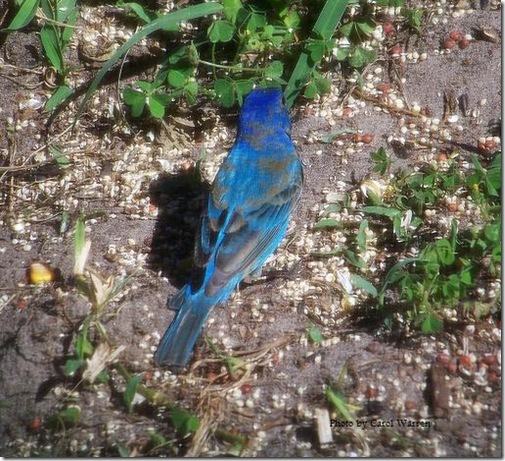 I’ve noticed that most of the “blues” are eating from the ground now. I don’t know if this is because the Painted Buntings rule the feeders or they just prefer ground feeding. It’s possible that some of the fallen seed has started to sprout. We’ve had some rain the last few days. I used to sprout seeds for my caged birds.
I’ve noticed that most of the “blues” are eating from the ground now. I don’t know if this is because the Painted Buntings rule the feeders or they just prefer ground feeding. It’s possible that some of the fallen seed has started to sprout. We’ve had some rain the last few days. I used to sprout seeds for my caged birds.
I don’t use any insect spray or weed spray….I certainly do not have a pretty lawn..but the birds like it and all the insects in and on it.
The Indigos, Painted Buntings and Cardinals all come in at the same time…talk about color..
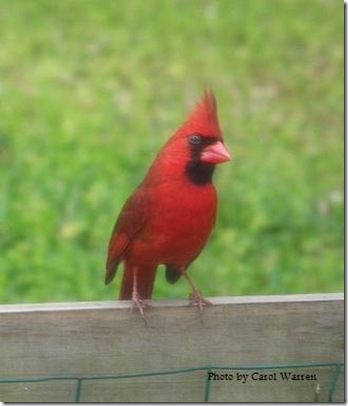 The Cardinals are usually the first birds to come in. All of the smaller ones seem to take their cue from them.
The Cardinals are usually the first birds to come in. All of the smaller ones seem to take their cue from them.
This squirrel comes to the feeder out back. I put down a bit of whole corn, twice a day. The rabbits, raccoons , turkeys and squirrels usually clean that up …It’s given as a treat ..not for them to depend upon. The bits and pieces left are finished by doves and Cardinals. This squirrel was waiting for the rabbit to leave.
I was finally able to get a fairly good picture of one of the Indigo Buntings, that come to the feeder each day. They are a bit more skittish than the Painted Buntings. The feeders are just outside my computer room window, so any movement can be seen and they are usually gone by the time I get the camera. Today I set up a “blind” by hanging a sheet on the blinds to block my movement. I am also taking pictures thru a window screen so I have to have the lens almost touching it to force it to focus on the subject instead of the screen. I have been pleasantly surprised at the quality of the pictures. I am using a Kodak Easy Share Z712 IS. Not and expensive camera.
These are not of the same bird. Look closely at the top of the head…The Indigo in the top picture has no brown on the top of his head. I knew they were not the same bird, because one was feeding while I snapped a couple of pictures then the next one flew in, chasing the first away.
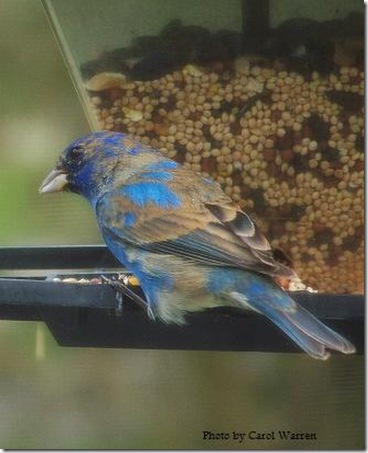 When they get their full color they will be as beautiful as that patch of bright blue on his wing. Scroll to the bottom and you will see one sitting on a feeder with a male Painted Bunting and a Green.
When they get their full color they will be as beautiful as that patch of bright blue on his wing. Scroll to the bottom and you will see one sitting on a feeder with a male Painted Bunting and a Green.
Each day the Painted Buntings get more beautiful…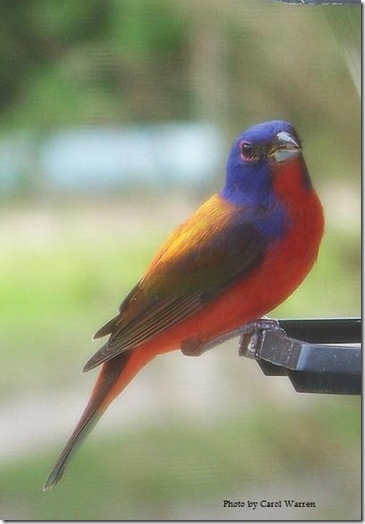 You can see the differences in their colors on the backs.
You can see the differences in their colors on the backs.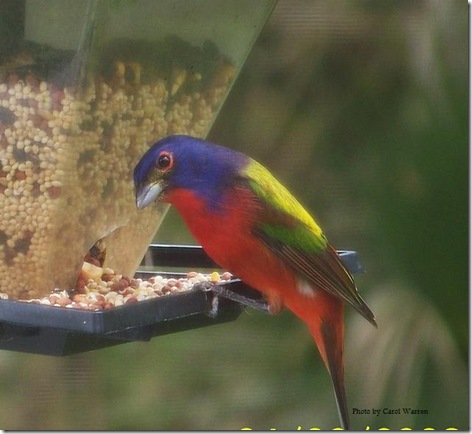 This green has a lot of yellow on the underside.
This green has a lot of yellow on the underside.  My camera has a long delay when you click the picture….and I ended up with this shot.
My camera has a long delay when you click the picture….and I ended up with this shot.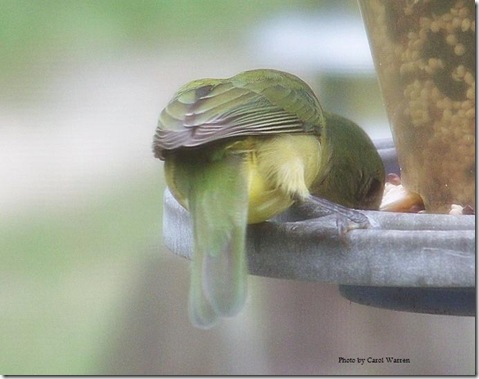 But it shows how much yellow there is.
But it shows how much yellow there is.
We have a small flock of around 12 Morning Doves.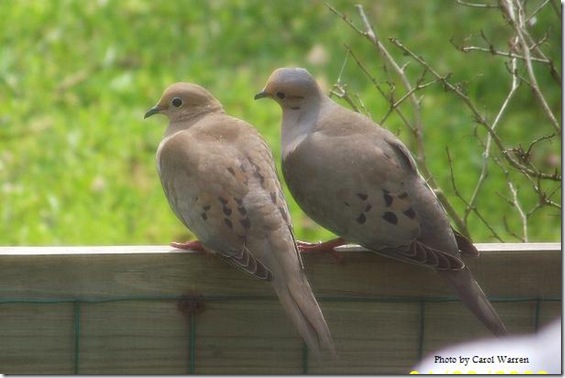 In the morning and evening, they come in all at once but generally there are only a few at the feeder , during the day. Most eat off the ground, but I do have one or two who have figured out how to sit on the top of one feeder and eat from the other. I had to separate them a bit or they will empty it in a day.
In the morning and evening, they come in all at once but generally there are only a few at the feeder , during the day. Most eat off the ground, but I do have one or two who have figured out how to sit on the top of one feeder and eat from the other. I had to separate them a bit or they will empty it in a day.
In this picture they look like they’ve fallen asleep….with their heads hanging down… …but…they are grooming themselves.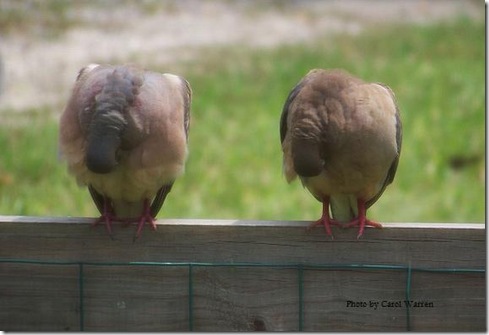
The fence they are sitting on encloses the dog’s yard. It is a small area, with bottle brush, honeysuckle vines, a tangelo tree, bougainvillea , and hibiscus planted around the outside for cover. Inside is a big jasmine bush. This helps break up the flight line of the hawks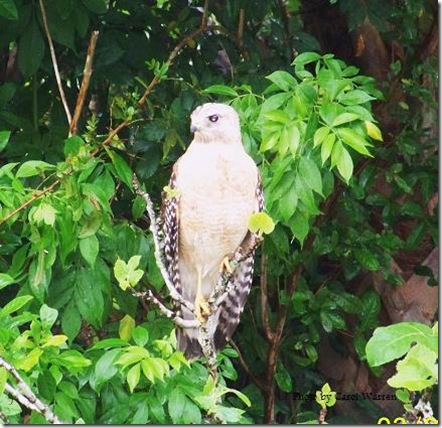 and gives the doves some protection. These are of the same Red Shouldered Hawk. He is sitting across the driveway from the feeders. He looks lighter in the top photo..he was sitting in bright sunshine then moved to the area under a cabbage palm, in the shade. It is a big beautiful bird.
and gives the doves some protection. These are of the same Red Shouldered Hawk. He is sitting across the driveway from the feeders. He looks lighter in the top photo..he was sitting in bright sunshine then moved to the area under a cabbage palm, in the shade. It is a big beautiful bird.
 The trees around the fenced yard provide the kind of low bushy cover the Buntings like.
The trees around the fenced yard provide the kind of low bushy cover the Buntings like.
My biggest problem is getting the feeders positioned so the squirrels cant jump to them..
I have been calling all my “green” birds females, when in fact, young males resemble the adult females. I normally see an adult male and a green bird come in together …and was calling them a pair. So my small flock can be a mixture of mature birds and adolescent males…as well as females.
The mature males are all in bright color.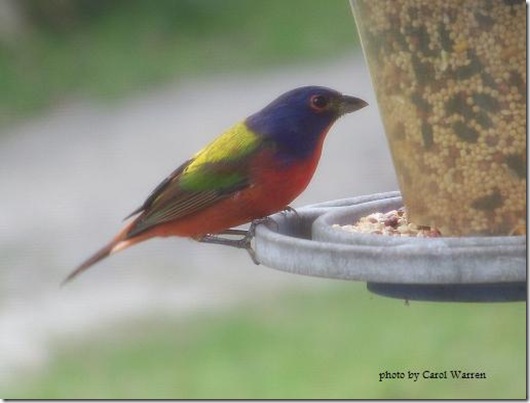 They usually head for their breeding grounds sometime around April. Today is April 1st and they are still here…Perhaps they will stay and raise their young nearby.
They usually head for their breeding grounds sometime around April. Today is April 1st and they are still here…Perhaps they will stay and raise their young nearby.